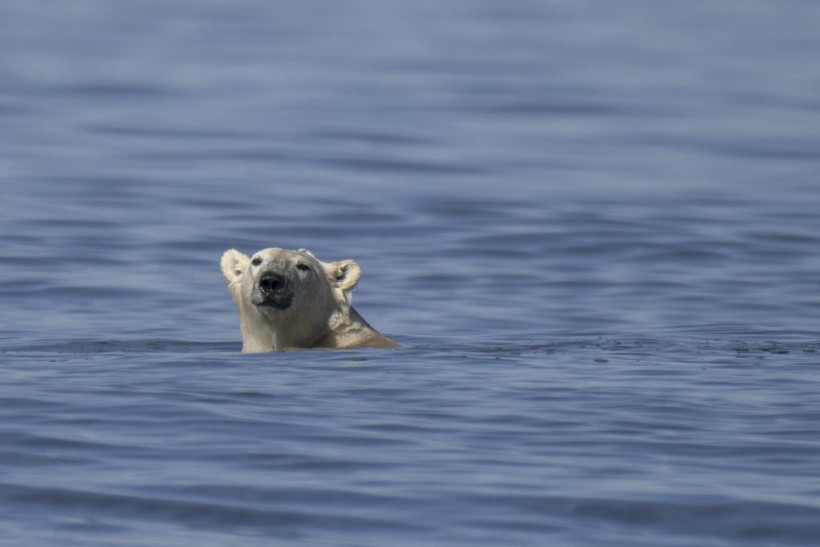Polar bears' survival depends on finding and using snow-covered dens to give birth and raise their cubs.
However, locating these dens is a challenge, as they are nearly invisible and buried under snow. This poses a risk for both the bears and the humans who share their habitat, as accidental disturbances or conflicts can have fatal consequences.
Fortunately, a new and improved radar technology may offer a solution to this problem.
Researchers from Simon Fraser University and Brigham Young University, collaborating with Polar Bears International, have tested an imaging system that relies on Synthetic Aperture Radar (SAR) to more effectively locate polar bear dens across the Arctic.
Their results, published in the journal Ursus, show that SAR increased den detection by more than 20%, or 66%, compared with the current method using aerial infrared (FLIR) cameras.
How SAR works and why it is better than FLIR
 (Photo : OLIVIER MORIN/AFP via Getty Images)
(Photo : OLIVIER MORIN/AFP via Getty Images)

SAR is a type of radar that uses microwave signals to create high-resolution images of objects and landscapes.
Unlike FLIR, which detects heat emitted by living beings, SAR can penetrate snow and ice and reveal the shape and structure of objects underneath.
This makes it possible to distinguish between a den and a snowdrift, as well as to see inside the den cavity.
According to SFU engineering science professor Bernhard Rabus, who holds an Industrial Research Chair in Synthetic Aperture Radar, their airborne imaging radar system has various capabilities at microwave frequencies that enable it to penetrate snow.
He said that the system could see both the top snow surface, the den roof surface and inside the den cavity.
He also explained that while their method was still in its research and testing phase, they expected to develop a robust detection technique for airborne SAR data to reliably detect polar bears inside their dens.
Another advantage of SAR is that it performs well regardless of temperature and weather conditions, which is crucial in the Arctic.
FLIR, on the other hand, can be affected by factors such as wind, cloud cover, or thermal contrast between the bear and the snow.
This can result in false positives or negatives, which can have serious implications for conservation efforts.
Also Read: Consequences of Climate Change: Polar Bear Population Shrinking Due to Arctic Sea Ice Melt
How SAR can help protect polar bears and humans
To prevent this from happening, it is essential to identify and avoid denning areas when planning or conducting human activities in polar bear habitats.
However, this is not easy with the current methods available.
FLIR cameras have been used for decades to locate dens from helicopters or planes, but they have limitations in accuracy and reliability.
Other methods include ground surveys with trained dogs or visual observation, but they are costly, time-consuming, and potentially dangerous.
SAR technology could provide a more efficient and effective way to locate dens and protect polar bears from human disturbances.
By using microwave signals instead of heat detection, SAR could reduce false positives or negatives and increase confidence in den identification.
This could help decision-makers plan and implement mitigation measures to avoid or minimize impacts on denning bears.
For example, they could establish buffer zones around dens, reroute activities away from denning areas, or monitor dens remotely with cameras or sensors.
Geoff York, senior director of research and policy at Polar Bears International, praised SAR as a promising method for polar bear den detection, which was critical for protecting polar bears alongside human activity.
He expressed his gratitude for the research partnership with SFU and BYU, and his excitement about the potential of SAR in the Arctic as it performed well in all weather conditions.
David Long, an electrical engineering professor and director of BYU's Center for Remote Sensing, noted that the research provided BYU undergraduate Capstone students an opportunity to do original research to identify and locate polar bears using radar.
He also expressed his confidence that SAR could be used in the Arctic areas to detect polar bears in the snow, and his hope that this technology would help protect these magnificent animals and their habitat.
Related article: Sea Stars Replace Polar Bears as Top Predators Along the Arctic Coast
© 2024 NatureWorldNews.com All rights reserved. Do not reproduce without permission.


![Climate Change is Reducing Dust Levels Worldwide as Arctic Temperature Warms [Study]](https://1471793142.rsc.cdn77.org/data/thumbs/full/70320/280/157/50/40/climate-change-is-reducing-dust-levels-worldwide-as-arctic-temperature-warms-study.jpg)

![Tsunami Hazard Zones: New US Map Shows Places at Risk of Flooding and Tsunamis Amid Rising Sea Levels [NOAA]](https://1471793142.rsc.cdn77.org/data/thumbs/full/70325/280/157/50/40/tsunami-hazard-zones-new-us-map-shows-places-at-risk-of-flooding-and-tsunamis-amid-rising-sea-levels-noaa.jpg)
